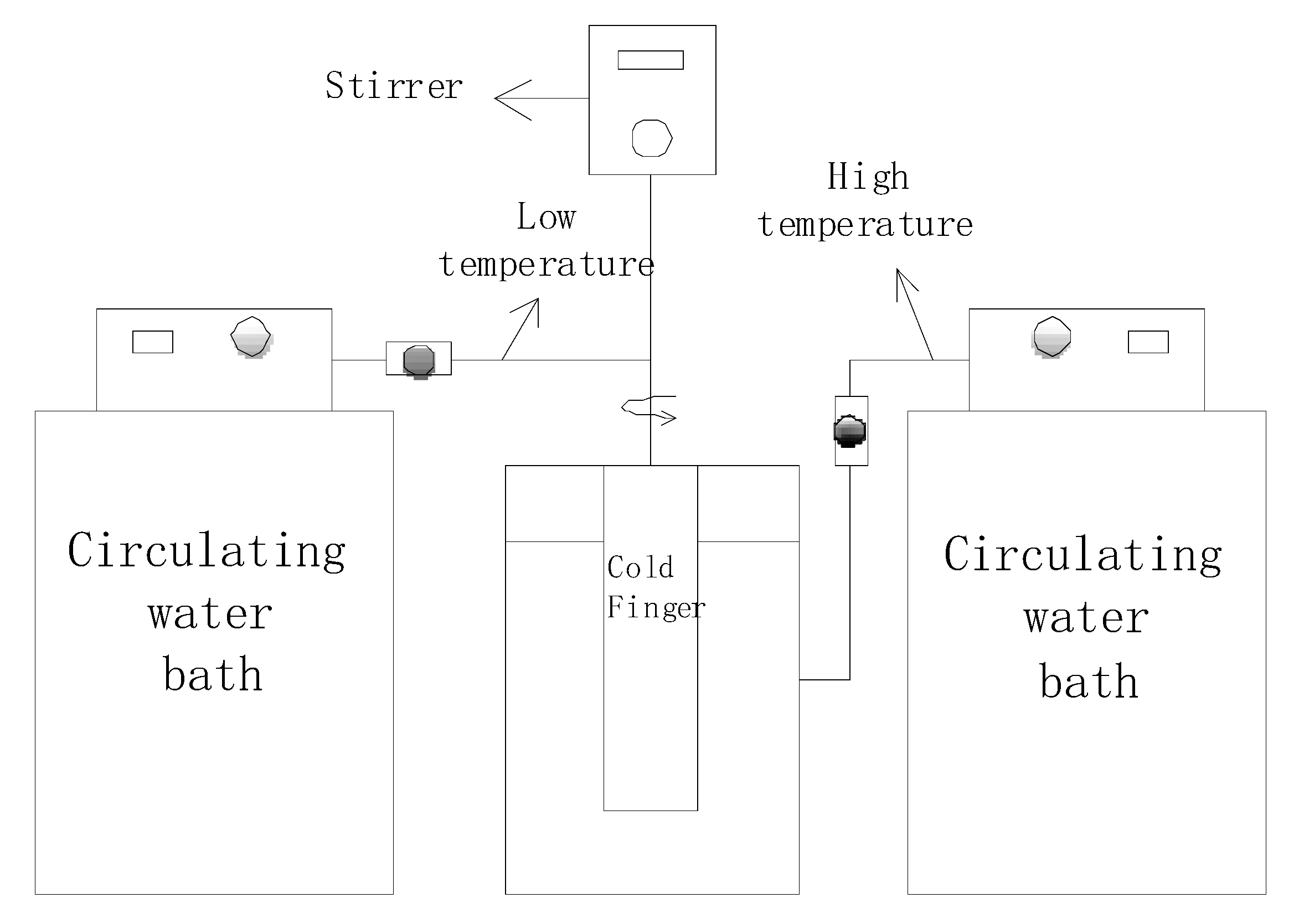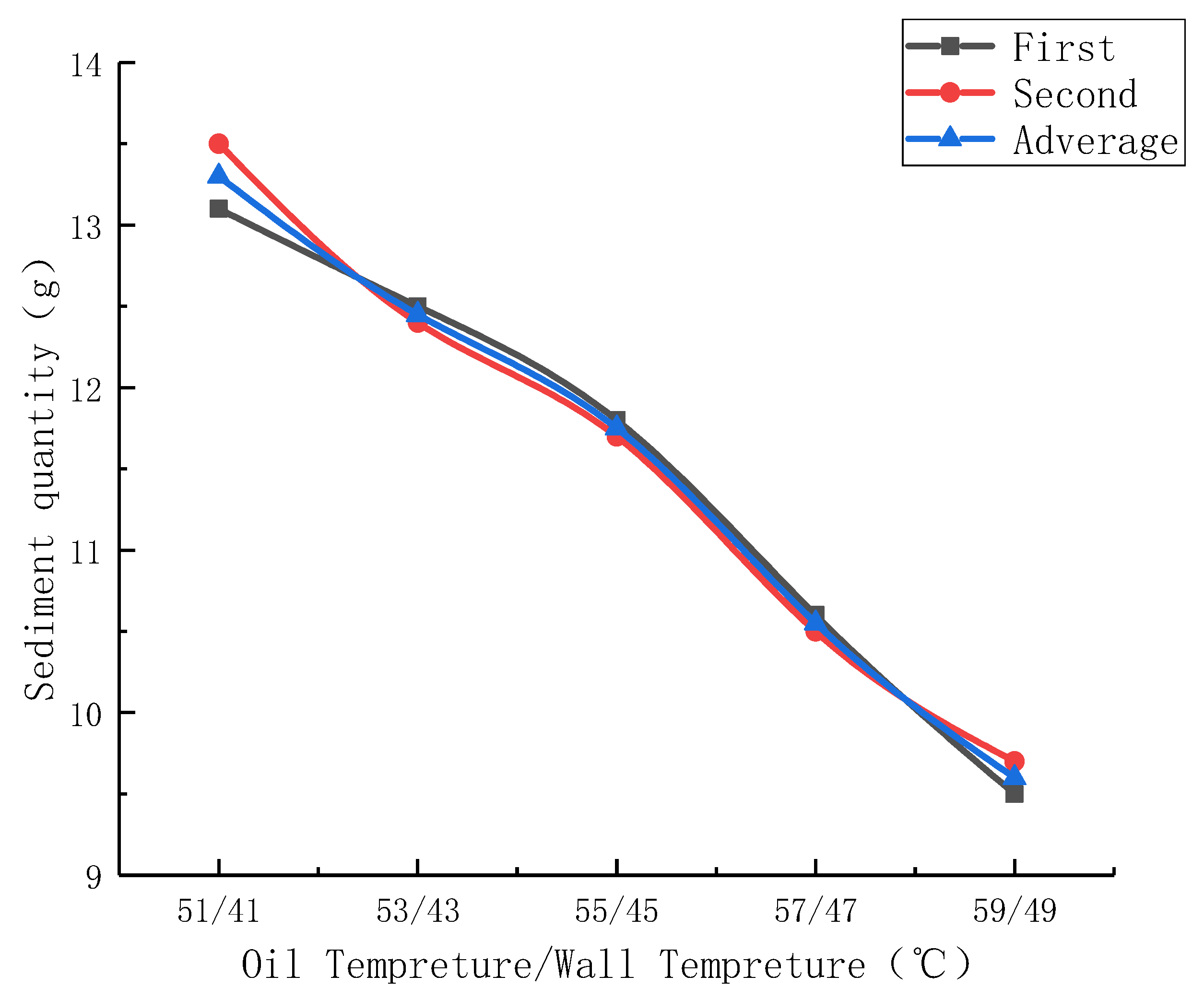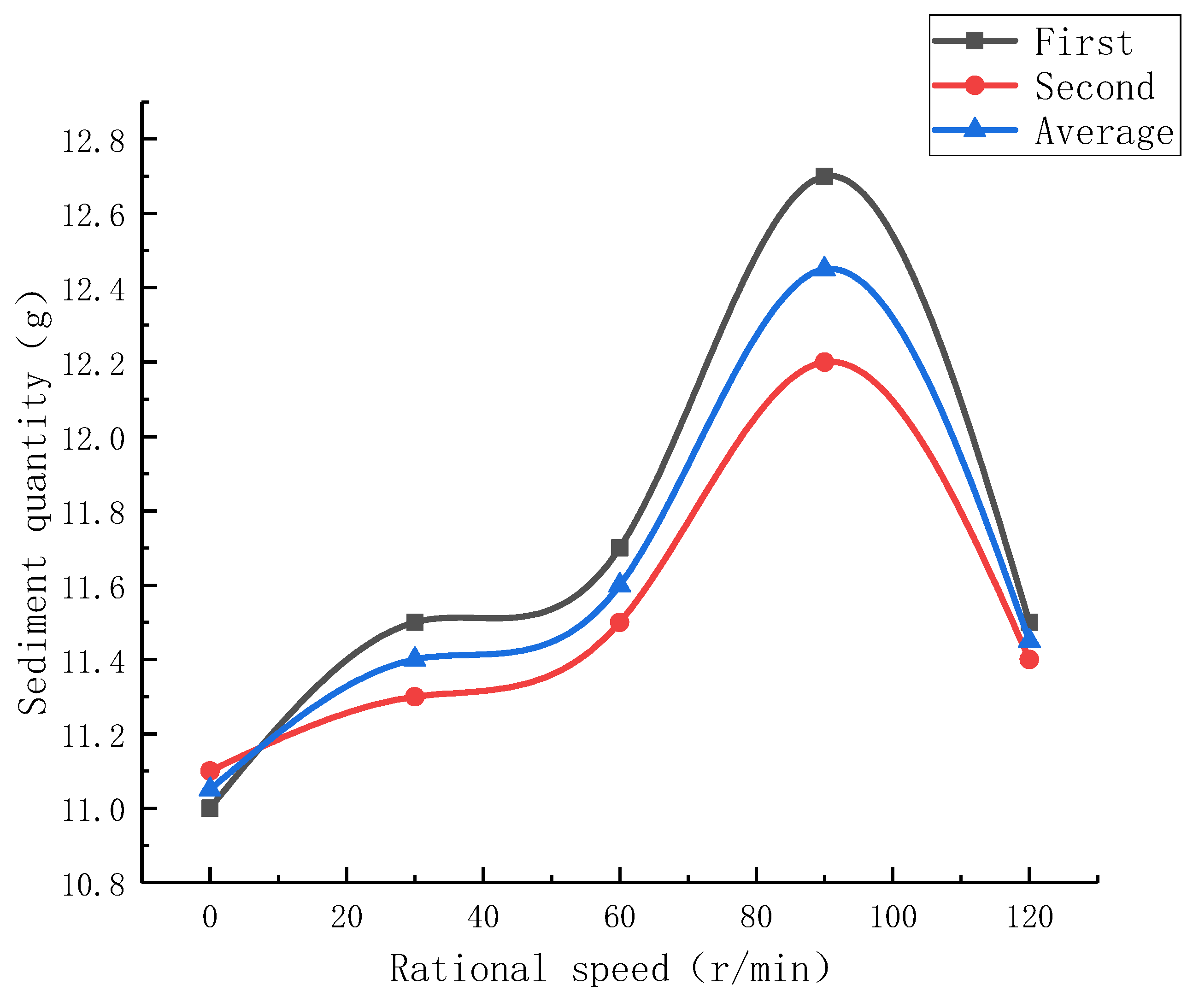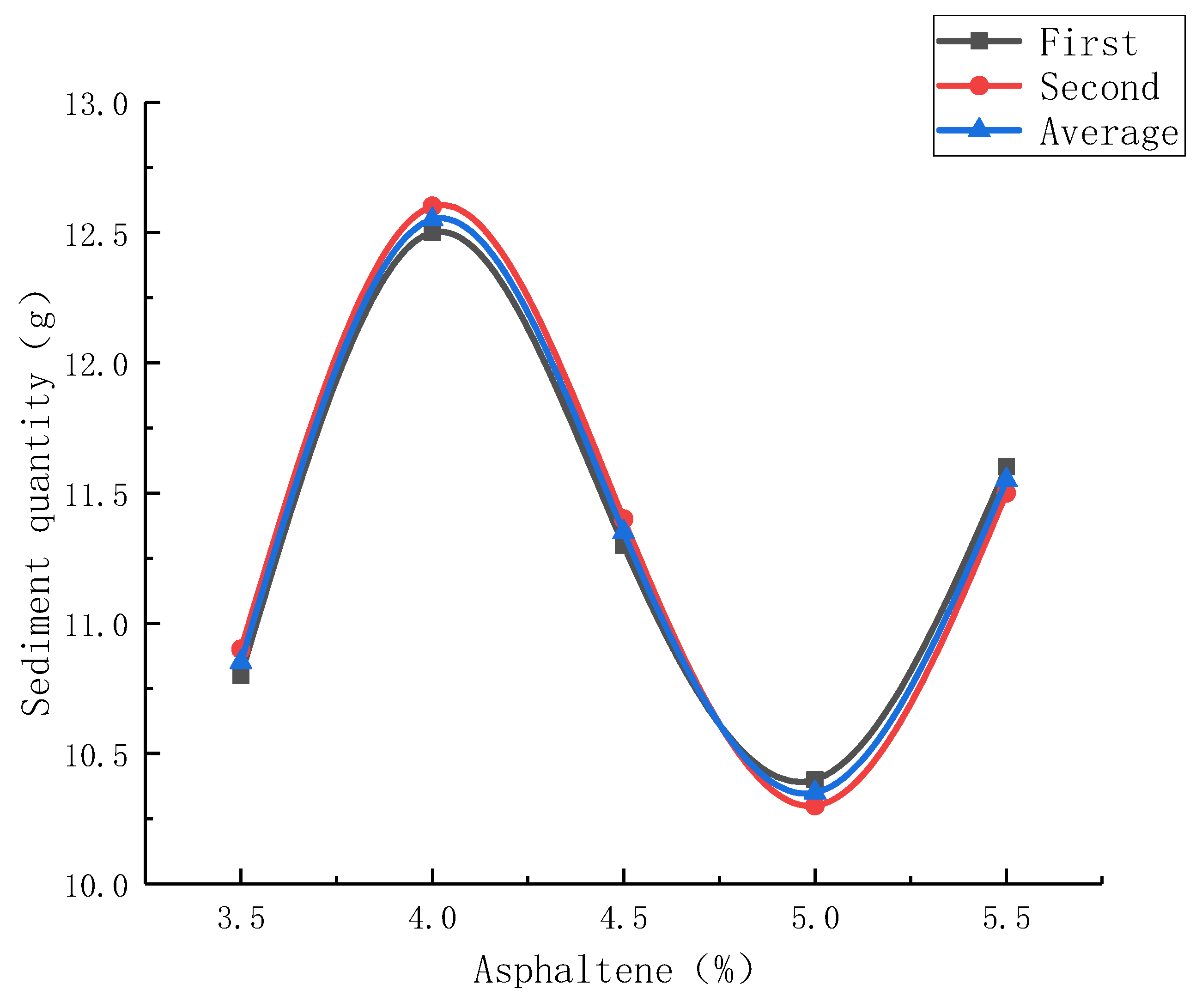Study of Wax Deposition Pattern of High Wax-Bearing Crude Oil Based on Cold Finger Experiment
Abstract
:1. Introduction
2. Materials and Methods
2.1. Experimental Setup
2.2. Experimental Medium
2.3. Experimental Steps
3. Result and Discussion
3.1. Oil Temperature
3.2. Temperature Interval
3.3. Deposition Time
3.4. Shear Strength
3.5. Oil Repellent Content
3.6. Asphaltene Content
4. Conclusions
Author Contributions
Funding
Conflicts of Interest
References
- Liu, G.; Fu, W.N.A.; Teng, H.X.; Zhang, G.Z.; Chen, L. Influence of rheometer response characteristics on yield stress test results of crude oil containing wax. Oil Gas Storage Transp. 2017, 36, 403–408. [Google Scholar]
- Oyekunle, L.; Adeyanju, O. Thermodynamic Prediction of Paraffin Wax Precipitation in Crude Oil Pipelines. Pet. Sci. Technol. 2011, 29, 208–217. [Google Scholar] [CrossRef]
- Hoteit, H.; Banki, R.; Firoozabadi, A. Wax deposition and aging in flowlines from irreversible thermodynamics. Energy Fuels 2008, 22, 2693–2706. [Google Scholar] [CrossRef]
- Sun, X.; Qian, X.; Jiang, X.; Xu, J. Some insights and judgments on the long-term development of the world oil and gas industry. Int. Pet. Econ. 2013, 21, 2–7. [Google Scholar]
- Wang, L. Research on Wax Cleaning Cycle and Wax Cleaning Process for Low Transmission Wax-Containing Crude Oil Pipelines. Master’s Thesis, Xi’an University of Petroleum, Xi’an, China, 2019. [Google Scholar]
- Hou, K.; Zhang, F.; Wang, S.; Zhang, Y.; Liu, K.; Zhang, Y.; Gao, Q.; Meng, J.; Meng, X. Study on wax deposition and pipe cleaning cycle of low transmission wax-containing crude oil pipeline. Oil Gas Field Surf. Eng. 2018, 37, 59–64. [Google Scholar]
- Ii, G.; Yan, M.; Li, X. Influence law of crude oil components on the wax precipitation characteristics of crude oil containing wax. Oil Gas Storage Transp. 2020, 39, 298–302. [Google Scholar]
- Weispfennig, K. Society of Petroleum Engineers SPE International Symposium on Oilfield Chemistry. In Proceedings of the SPE International Symposium on Oilfield Chemistry—Advancements in Paraffin Testing Methodology, Houston, TX, USA, 13–16 February 2001. [Google Scholar]
- Zhang, Y.; Gong, J.; Ren, Y.; Wang, P. Effect of Emulsion Characteristics on Wax Deposition from Water-in-Waxy Crude Oil Emulsions under Static Cooling Conditions. Energy Fuels 2010, 24, 1146–1155. [Google Scholar] [CrossRef]
- Wang, P.Y.; Yao, H.Y.; Gong, J.; Yang, W.; Zhou, Y.X.; Liu, H.S. Experimental study on cold finger of oil-in-water emulsion wax deposition. China Offshore Oil Gas 2014, 26, 114–118. [Google Scholar]
- Fan, K.; Li, S.; Li, R. Development of wax molecular diffusivity correlation suitable for crude oil in wax deposition: Experiments with a cold-finger apparatus. J. Pet. Sci. Eng. 2021, 205, 108851. [Google Scholar] [CrossRef]
- Fan, K.; Li, S.; Huang, Q. Progress in the study of radial properties of wax deposits in crude oil pipelines. Chem. Prog. 2020, 40, 3679–3692. [Google Scholar] [CrossRef]
- Huang, Q.Y.; Zhang, J.J.; Yan, D.A.F. A new model for wax deposition. Oil Gas Storage Transp. 2003, 11, 22–25. [Google Scholar] [CrossRef]
- Jennings, D.W.; Weispfennig, K. Effects of Shear and Temperature on Wax Deposition: Coldfinger Investigation with a Gulf of Mexico Crude Oil. Energy Fuels 2005, 19, 1376–1386. [Google Scholar] [CrossRef]
- Li, R.; Li, W.; Huang, Q.; Wang, W.; Dong, X.; Zhao, Q. Effect of temperature on wax deposition in subsea wax-containing crude oil pipelines. Pipeline Technol. Equip. 2019, 1, 4–7. [Google Scholar] [CrossRef]
- Ye, B.; Yu, X.; Peng, W.; Wu, Y. Prediction and simulation of wax deposition in wax-containing crude oil pipelines in offshore deepwater subsea. J. China Univ. Pet. (Nat. Sci. Ed.) 2019, 43, 159–166. [Google Scholar]
- Liu, C.; Luan, S.; Han, W.; Zhang, X.; Wang, X.; Li, Z.; Du, J.; Guan, Z. Comparative test on the factors influencing wax deposition of crude oil containing wax. Oil Gas Storage Transp. 2021, 40, 78–83. [Google Scholar]
- Cheng, Q.L.; Liu, Y.; Liu, X.Y. Energy use description and energy consumption evaluation of pipeline transmission process of crude oil containing wax. Oil Gas Storage Transp. 2017, 36, 617–623. [Google Scholar]
- Li, C.; Bai, F.; Wang, Y. Influence of crude oil composition on the wax formation pattern of crude oil pipelines. J. Chem. Eng. 2014, 65, 4571–4578. [Google Scholar]







Publisher’s Note: MDPI stays neutral with regard to jurisdictional claims in published maps and institutional affiliations. |
© 2022 by the authors. Licensee MDPI, Basel, Switzerland. This article is an open access article distributed under the terms and conditions of the Creative Commons Attribution (CC BY) license (https://creativecommons.org/licenses/by/4.0/).
Share and Cite
Wei, L.; Li, D.; Liu, C.; He, Z.; Ge, Y. Study of Wax Deposition Pattern of High Wax-Bearing Crude Oil Based on Cold Finger Experiment. Processes 2022, 10, 103. https://doi.org/10.3390/pr10010103
Wei L, Li D, Liu C, He Z, Ge Y. Study of Wax Deposition Pattern of High Wax-Bearing Crude Oil Based on Cold Finger Experiment. Processes. 2022; 10(1):103. https://doi.org/10.3390/pr10010103
Chicago/Turabian StyleWei, Lixin, Da Li, Chao Liu, Zhaojun He, and Yang Ge. 2022. "Study of Wax Deposition Pattern of High Wax-Bearing Crude Oil Based on Cold Finger Experiment" Processes 10, no. 1: 103. https://doi.org/10.3390/pr10010103
APA StyleWei, L., Li, D., Liu, C., He, Z., & Ge, Y. (2022). Study of Wax Deposition Pattern of High Wax-Bearing Crude Oil Based on Cold Finger Experiment. Processes, 10(1), 103. https://doi.org/10.3390/pr10010103




